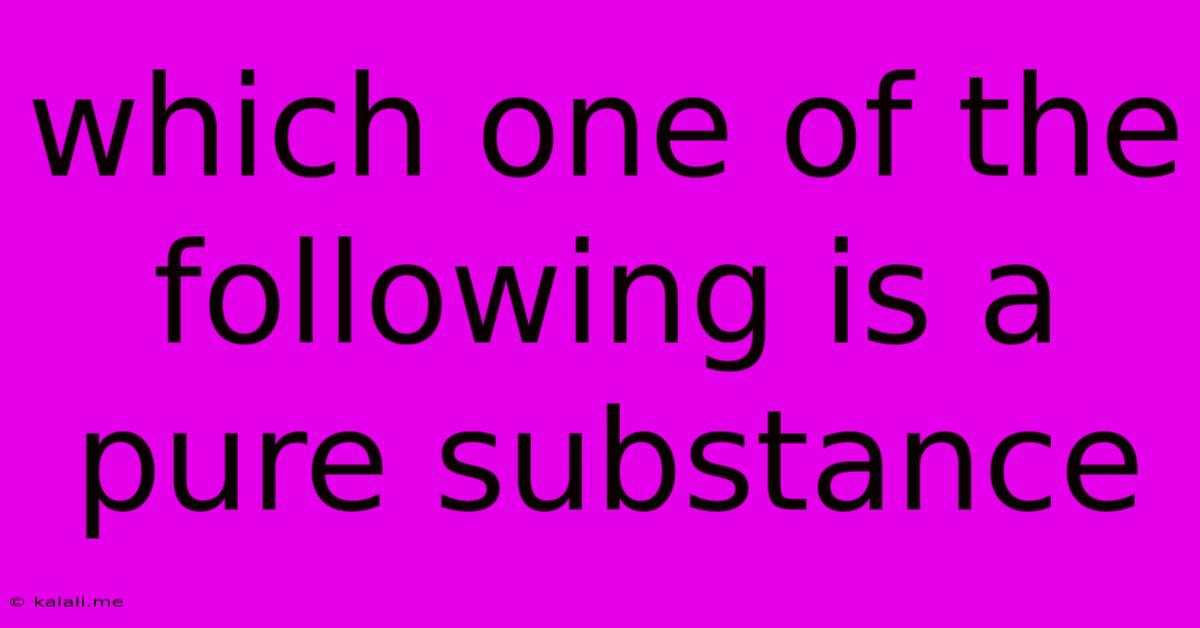Which One Of The Following Is A Pure Substance
Kalali
Jun 14, 2025 · 3 min read

Table of Contents
Which One of the Following is a Pure Substance? Understanding Matter and its Composition
This article will delve into the concept of pure substances, differentiating them from mixtures and exploring examples to solidify your understanding. Understanding the difference between pure substances and mixtures is fundamental to chemistry and numerous scientific disciplines. This guide will provide a clear explanation and examples to help you confidently identify a pure substance.
What is a Pure Substance?
A pure substance is a form of matter that has a constant composition (meaning it's made up of only one type of atom or molecule) and has consistent properties throughout the sample. This means that no matter where you take a sample from the substance, its chemical makeup and physical properties will remain the same. This contrasts sharply with mixtures, which are composed of two or more different substances.
Types of Pure Substances:
Pure substances are categorized into two main types:
-
Elements: These are fundamental substances that cannot be broken down into simpler substances by chemical means. They are composed of only one type of atom. Examples include oxygen (O), gold (Au), and hydrogen (H). The periodic table organizes and displays all known elements.
-
Compounds: These are substances formed when two or more elements are chemically bonded together in fixed ratios. They can be broken down into simpler substances (their constituent elements) through chemical reactions. Examples include water (H₂O), sodium chloride (NaCl – table salt), and carbon dioxide (CO₂). Note that the ratio of elements in a compound is crucial – a different ratio creates a different compound.
Distinguishing Pure Substances from Mixtures:
The key difference lies in the composition and properties:
-
Pure Substances: Have a fixed composition and consistent properties throughout. They have a distinct melting point and boiling point.
-
Mixtures: Have a variable composition and properties can vary depending on the proportion of the components. They typically have a melting point and boiling point range instead of a single value.
Mixtures can be further classified into homogeneous and heterogeneous mixtures:
-
Homogeneous Mixtures: The components are uniformly distributed throughout the mixture. An example is saltwater, where the salt is evenly dissolved in the water.
-
Heterogeneous Mixtures: The components are not uniformly distributed. A salad is a good example; you can easily see the different ingredients.
Examples and How to Identify a Pure Substance:
Let's consider some examples:
- Air: A mixture of gases (nitrogen, oxygen, carbon dioxide, etc.). It's not a pure substance.
- Water: Pure water (H₂O) is a pure substance (a compound). However, tap water is a mixture because it contains dissolved minerals and other impurities.
- Sugar (Sucrose): Pure sucrose (C₁₂H₂₂O₁₁) is a pure substance (a compound).
- Steel: An alloy, which is a mixture of iron and carbon (and other elements). It's not a pure substance.
- Gold: A pure element.
To determine if something is a pure substance, you would need to analyze its composition to check for consistency and uniformity. Techniques like chromatography and spectroscopy can be used to identify the components of a substance.
In Conclusion:
Identifying a pure substance requires a clear understanding of its composition and properties. Pure substances, whether elements or compounds, maintain a fixed composition and consistent properties, unlike mixtures which have variable compositions. This knowledge is fundamental in various scientific fields and essential for accurate analysis and experimentation.
Latest Posts
Latest Posts
-
The Deformation Per Unit Length Is Called
Jun 14, 2025
-
What Is The Lcm Of 9 And 10
Jun 14, 2025
-
Which Of The Following Is A Covalent Molecule
Jun 14, 2025
-
Which Of The Following Is Not A Property Of Metalloids
Jun 14, 2025
-
Joule Second Is The Unit Of
Jun 14, 2025
Related Post
Thank you for visiting our website which covers about Which One Of The Following Is A Pure Substance . We hope the information provided has been useful to you. Feel free to contact us if you have any questions or need further assistance. See you next time and don't miss to bookmark.